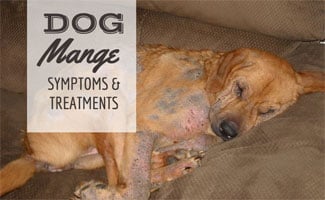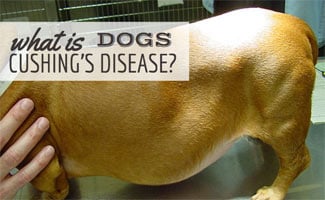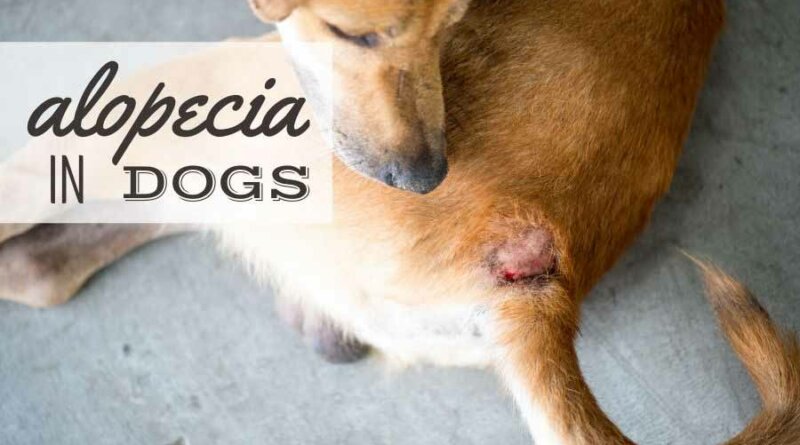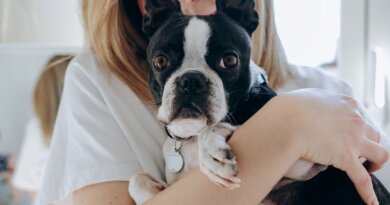Is Your Dog Losing More Hair Than Usual? – CanineJournal.com
[ad_1]
We all know that dogs shed their fur — we find it often enough on our clothes and furniture. But what if your dog’s coat is starting to look a bit patchy, or there are small bald spots on your dog? Hair loss in dogs is known as alopecia. Let’s explore some of the causes of alopecia in dogs, the diagnostic tests, and some treatment options your veterinarian might suggest.
Article Overview
What Is Alopecia In Dogs?
Alopecia means hair loss, either because the hair has failed to grow or it has fallen out. This can affect any part of the body and ranges from small bald spots (sometimes known as alopecia areata in dogs) to widespread areas. ‘Can dogs get alopecia?’ is a common question, but alopecia occurs in other species, too, including humans.
Why Do Dogs Get Alopecia?
 Alopecia can occur because of damage to the hair follicles, which usually happens due to trauma, inflammation, or infection. It can also occur because of underlying hormonal issues and other conditions.
Alopecia can occur because of damage to the hair follicles, which usually happens due to trauma, inflammation, or infection. It can also occur because of underlying hormonal issues and other conditions.
Alopecia in dogs is not often due to an inherited genetic condition (dogs don’t tend to have it from birth — unlike some people). Instead, it’s often secondary to an underlying health condition.
What Are Possible Causes?
There are many different causes of alopecia in dogs. Most of them are treatable with the correct medication. However, some conditions can be a bit more complicated. Here are some of the common causes and types of alopecia in dogs:
1. Parasites
 Mange mites can cause hair loss. Both demodectic mange and sarcoptic mange can cause bald patches and areas of inflamed skin. Fleas can also cause problems, particularly if your dog suffers from flea allergic dermatitis (FAD). An exaggerated reaction to flea bites can lead to skin inflammation and intense nibbling and scratching, which can all cause fur loss.
Mange mites can cause hair loss. Both demodectic mange and sarcoptic mange can cause bald patches and areas of inflamed skin. Fleas can also cause problems, particularly if your dog suffers from flea allergic dermatitis (FAD). An exaggerated reaction to flea bites can lead to skin inflammation and intense nibbling and scratching, which can all cause fur loss.
2. Fungal Or Bacterial Infections
Fungal infections like ringworm (dermatophytosis) can cause areas of hair loss along with scaling or crusting of the skin, but ringworm is not usually itchy. Ringworm is one of the more common causes of small bald spots in dogs. Veterinarians usually make a diagnosis based on fungal culture results from samples of fur and skin. Ringworm is zoonotic, meaning that people can catch it, so if you have any unusual areas of skin yourself, then you should speak to your doctor.
Bacterial infections can cause damage to the skin and hair follicles, leading to pyoderma. Nibbling or scratching due to inflammation can also further lead to alopecia.
3. Skin Reactions Or Trauma
Some animals react to topical treatments like flea medications, especially if they have very sensitive skin. This can lead to a patch of hair loss. Trauma to the skin caused by burns or scars from surgery can also damage hair follicles, leading to bald areas.
4. Seasonal Alopecia
 This cause is cosmetic rather than involving underlying health concerns. With seasonal alopecia, thinning or loss of fur occurs on one or both sides of dogs (on their flanks). So, this condition is also known as seasonal flank alopecia in dogs. It often occurs in the winter months, with the skin itself remaining healthy. It’s most commonly seen in breeds like Boxers, Doberman Pinschers, and English Bulldogs and is thought to be due to an underlying hormonal issue.
This cause is cosmetic rather than involving underlying health concerns. With seasonal alopecia, thinning or loss of fur occurs on one or both sides of dogs (on their flanks). So, this condition is also known as seasonal flank alopecia in dogs. It often occurs in the winter months, with the skin itself remaining healthy. It’s most commonly seen in breeds like Boxers, Doberman Pinschers, and English Bulldogs and is thought to be due to an underlying hormonal issue.
Since seasonal alopecia doesn’t cause pain or distress, vets generally don’t recommend treatment. However, some claim that melatonin can help in some cases. Check out the video below to see what seasonal flank alopecia looks like.
5. Alopecia X
Alopecia X usually presents as symmetrical hair loss on the dog’s body, tail, and neck. Your dog’s skin might appear darker than usual too. This is a cosmetic issue and doesn’t cause your dog any discomfort. The condition is rare, with the exact cause still unknown, but it’s likely due to unbalanced sex hormone levels.
6. Pattern Baldness
Is your dog losing hair on his head? Then he could have a type of alopecia called pattern baldness. This type of alopecia most frequently affects Chihuahuas, Boston Terriers, Whippets, and Bull Terriers. Thinning of the fur around the ears, head, and neck is common. There are no dog hair loss solutions for this. However, it doesn’t cause the dog any discomfort and doesn’t appear to be itchy.
7. Hormonal Causes
Endocrine Hypothyroidism
Endocrine hypothyroidism can affect your dog’s coat, causing non-itchy symmetrical endocrine alopecia. This underproduction of thyroid hormones can cause other symptoms, too, such as weight gain and lethargy.
Cushing’s Disease
 Another hormone-driven cause of alopecia is Cushing’s disease. Also known as hyperadrenocorticism, this condition is caused by the overproduction of steroid hormones in the body.
Another hormone-driven cause of alopecia is Cushing’s disease. Also known as hyperadrenocorticism, this condition is caused by the overproduction of steroid hormones in the body.
This causes side effects, including thinning of the skin, hair loss, a pot-bellied appearance, and changes in appetite and thirst. Both hormone issues are diagnosed through blood tests and can be managed with medication.
8. Testicular Tumors
 Sertoli cell tumors are a less common explanation but tend to be found in male dogs with retained (undescended) testicles (aka cryptorchidism).
Sertoli cell tumors are a less common explanation but tend to be found in male dogs with retained (undescended) testicles (aka cryptorchidism).
This tumor causes hormonal changes leading to alopecia, darkening of the skin, and enlargement of the mammary glands. Surgical removal of the testicles usually resolves symptoms.
Diagnosing Alopecia In Dogs
Your veterinarian will start by examining your dog’s overall health, as well as his skin. This may give your vet clues about underlying conditions like hypothyroidism or a Sertoli cell tumor. Your vet may also recommend blood tests to gauge your dog’s health and organ functions, as well as specific tests to look at hormonal conditions.
Depending on these initial findings, your vet may recommend taking samples of your dog’s skin for culture in the case of suspected ringworm or pyoderma. Skin scrapes also allow your vet to examine for parasites like mange mites. Your vet may also need biopsies of your dog’s skin, which involves cutting small pieces of the skin to send for lab analysis.
Alopecia In Dogs Treatment
 You might now be wondering how to treat hair loss in dogs. Well, the treatment for dog alopecia depends on what caused it in the first place.
You might now be wondering how to treat hair loss in dogs. Well, the treatment for dog alopecia depends on what caused it in the first place.
There’s no specific dog shampoo for hair loss. Instead, any topical treatments advised are usually aimed at clearing up infections and helping to generally improve the condition of the skin.
If the hair loss occurred due to a parasite infestation then anti-parasite products will be prescribed by your vet. For fungal infections, special shampoos and oral medication may be prescribed. Pyoderma (bacterial infections) are often treated with medicated shampoos too. Oral antibiotics may also be required.
For hormonal conditions, your vet may prescribe medications to treat the problem. Animals with hypothyroidism and Cushing’s disease require ongoing treatment. Neutering is recommended for dogs with Sertoli cell tumors and may be helpful with alopecia X as well.
It’s worth bearing in mind that some cases of alopecia are cosmetic, so treatment is not always warranted (as in the case of seasonal flank alopecia). Melatonin may be useful in a few of these cases but your veterinarian can advise you further.
Are There Home Remedies?
As mentioned before, there’s usually an underlying cause, so dog hair loss treatment revolves around getting a diagnosis for the underlying problem. You should always seek professional advice rather than just googling ‘alopecia in dogs cure,’ as many home remedies could be ineffective. There’s no single home remedy for alopecia in dogs — only your vet can help you understand how to fix alopecia in dogs, as each case is different.
Can It Be Stopped And Reversed?
The prognosis for dogs with alopecia is usually good, especially when diagnosed and treated promptly. Resolving any underlying problems like infections or hormonal issues usually leads to resolution of the alopecia and the fur starts to regrow.
If your dog has a slightly more unusual cause like alopecia X, then this tends to be a cosmetic issue. So while it may be harder to treat the hair loss, rest assured that your dog is comfortable. He also probably doesn’t care what he looks like, even if you do.
Does Your Dog Have Other Skin Problems?
Is your dog’s skin frequently itchy, rashy, scabby, or bumpy? Dogs suffer from a host of skin problems that don’t always cause hair loss. If this sounds like your pup, he could be suffering from skin allergies from something in his food or environment. Skin infections are also common in dogs, so you may want to know the signs of infection and when it’s time to see your vet.
[ad_2]
Source link





order lanoxin 250mg generic brand digoxin 250 mg buy molnunat 200 mg generic
diamox for sale buy imdur 40mg pill buy azathioprine online
lanoxin 250mg ca order micardis 20mg generic cheap molnunat 200mg
carvedilol over the counter generic ditropan 2.5mg amitriptyline online
amoxil cheap buy generic stromectol 6mg ivermectin 1%cream
fosamax sale buy alendronate 35mg pill order ibuprofen online
dapoxetine 60mg drug purchase priligy pills domperidone 10mg canada
purchase pamelor online paxil for sale paroxetine price
buy indocin generic oral tamsulosin buy cenforce 100mg pill
buy pepcid 40mg generic order pepcid 40mg sale remeron 15mg usa
doxycycline price medrol 4 mg without a doctor prescription medrol 8mg oral
requip 2mg cheap labetalol usa trandate 100 mg us
tadalafil 10mg cheap cost trimox 250mg buy amoxicillin 500mg sale
order fenofibrate 160mg pill purchase viagra online cheap brand viagra
nexium 40mg us nexium drug oral lasix 40mg
overnight delivery for cialis Best prices on cialis buy sildenafil 50mg without prescription
order minocycline pills order hytrin 5mg for sale hytrin online order
cost cialis 10mg buy ed medication natural ed pills
cost glucophage 500mg buy calan 120mg generic nolvadex 10mg uk
modafinil 100mg usa modafinil for sale online promethazine 25mg without prescription
order generic clomid order clomid 100mg prednisolone 40mg cheap
brand prednisone buy amoxicillin 500mg pills order amoxicillin 250mg generic
buy accutane 10mg generic purchase isotretinoin pill buy ampicillin without prescription
cost sildenafil 50mg buy ed pills gb order proscar
generic name for ivermectin ed pills otc deltasone 40mg generic
buy zofran 4mg pills purchase ondansetron generic bactrim 960mg over the counter
isotretinoin oral purchase azithromycin pill purchase azithromycin online cheap
ventolin 4mg pill order albuterol online cheap order augmentin 375mg sale
provigil 200mg oral buy lopressor 50mg online cheap lopressor 100mg without prescription
order prednisolone 20mg order prednisolone 10mg pills lasix 100mg generic
avodart pills dutasteride online xenical online buy
buy doxycycline for sale order zovirax 400mg pills buy acyclovir for sale
buy imuran naproxen 250mg canada naprosyn over the counter
oxybutynin 2.5mg pill oxcarbazepine over the counter buy trileptal 300mg for sale
omnicef pills cefdinir 300mg brand order pantoprazole 40mg online cheap
simvastatin 10mg oral sildalis pill buy sildalis pill
order avlosulfon 100 mg online cheap purchase mesalamine without prescription buy tenormin generic
buy alfuzosin 10mg without prescription diltiazem pills diltiazem usa
generic viagra 50mg sildenafil 25mg tadalafil 10mg tablet
buy phenergan sale order provigil 200mg sale generic for cialis
order zetia 10mg online buy methotrexate without prescription buy cheap generic methotrexate
levaquin drug generic zyban 150mg bupropion for sale online
medex where to buy warfarin brand buy zyloprim 100mg pill
order cetirizine 5mg online cheap brand atomoxetine sertraline cost
cenforce generic aralen 250mg us order glycomet without prescription
cheap lexapro 10mg how to buy escitalopram revia 50mg without prescription
atorvastatin 40mg pills atorvastatin 40mg uk buy viagra 100mg online cheap
buy letrozole paypal cheap sildenafil generic viagra for women
order amoxicillin 1000mg pill buy prednisolone 20mg prednisolone 10mg sale
buy accutane 20mg isotretinoin online order zithromax 500mg without prescription
purchase neurontin online cheap buy generic lasix 100mg buy cheap doxycycline
prednisolone 20mg sale cheap prednisolone sale lasix price
albuterol canada purchase levoxyl online cheap synthroid 150mcg for sale
serophene for sale generic vardenafil order hydroxychloroquine pills
doxycycline price purchase albuterol pills buy generic clavulanate
order tenormin 50mg pill medrol 4mg tablet order femara 2.5 mg online
synthroid 75mcg ca buy vardenafil 10mg pill buy vardenafil 20mg
cheap albendazole 400mg provera 5mg cost provera 10mg uk
metformin 1000mg over the counter buy norvasc 5mg online order norvasc 5mg for sale
praziquantel generic praziquantel 600 mg without prescription generic periactin 4mg
buy zestril 5mg online order prilosec metoprolol 50mg uk
pregabalin price loratadine order online buy dapoxetine 30mg for sale
buy methotrexate for sale buy methotrexate online cheap metoclopramide online order
orlistat oral zyloprim 100mg tablet generic zyloprim 100mg
losartan 25mg for sale topamax without prescription topamax generic
rosuvastatin 20mg cost buy generic domperidone over the counter purchase motilium online cheap
order sumatriptan for sale order levaquin 500mg generic buy generic avodart for sale
sumycin price buy lioresal online cheap baclofen 25mg us
how to buy toradol buy generic inderal online propranolol uk
zantac sale meloxicam over the counter celebrex price
cost clopidogrel nizoral 200mg without prescription buy nizoral pills
flomax cost buy tamsulosin 0.2mg for sale order aldactone 100mg pill
buy duloxetine 40mg online cheap buy piracetam 800 mg sale nootropil pill
betamethasone 20gm cheap clomipramine 50mg us purchase sporanox generic
ipratropium for sale online purchase linezolid without prescription order generic zyvox
progesterone 200mg oral buy prometrium without prescription buy zyprexa without a prescription
generic starlix atacand 8mg uk buy candesartan pills
buy bystolic generic clozapine 100mg generic purchase clozaril sale
buy simvastatin 10mg sildenafil buy online viagra tablet
buy carbamazepine paypal order ciprofloxacin 500 mg generic lincomycin 500 mg ca
order duricef online buy lamivudine sale buy propecia 1mg without prescription
diflucan 200mg sale ampicillin uk buy ciprofloxacin no prescription
order generic estrace 2mg purchase minipress pill order minipress sale
metronidazole canada septra pills cephalexin pill
mebendazole tablet order tretinoin cream generic buy tadalis 20mg without prescription
buy cleocin pills for sale order erythromycin pills purchase sildenafil online
order tamoxifen 20mg generic buy tamoxifen 10mg generic order ceftin online cheap
buy indomethacin 50mg pills lamisil 250mg sale cefixime 200mg drug
buy amoxicillin sale arimidex 1mg cost buy clarithromycin 500mg for sale
bimatoprost tablet buy trazodone 50mg desyrel online
purchase catapres pill buy catapres generic buy cheap generic spiriva
order sildenafil 50mg generic suhagra 100mg brand buy generic sildalis over the counter
order minocycline 100mg capsules buy minocin pills pioglitazone 30mg canada
purchase accutane for sale order generic zithromax 500mg oral azithromycin 250mg
arava price buy sulfasalazine generic sulfasalazine 500 mg usa
buy azithromycin for sale neurontin oral how to get gabapentin without a prescription
order generic tadalafil 5mg cialis generic buy cialis 20mg sale
purchase furosemide sale ventolin cost antihistamine drugs list
stromectol 3 mg dosage buy generic ed pills deltasone 5mg without prescription
purchase vardenafil plaquenil pills where to buy plaquenil without a prescription
buy ramipril 10mg pills generic arcoxia 120mg buy arcoxia sale
order generic levitra tizanidine canada hydroxychloroquine 200mg cheap
buy mesalamine generic irbesartan 300mg brand irbesartan 300mg sale
olmesartan generic calan 120mg brand cost depakote
buy generic carvedilol online order coreg 25mg online order aralen 250mg generic
order diamox sale order azathioprine 25mg pill brand azathioprine
buy generic lanoxin 250 mg buy generic molnupiravir 200 mg molnupiravir order online
naprosyn without prescription buy omnicef 300 mg pills buy lansoprazole 30mg generic
baricitinib 4mg without prescription buy lipitor 20mg generic order generic atorvastatin
brand albuterol 100mcg albuterol 100mcg pill order pyridium without prescription
where to buy singulair without a prescription buy cheap generic singulair buy avlosulfon generic
buy generic norvasc for sale buy norvasc oral omeprazole 10mg
adalat cost order adalat 30mg online cheap buy fexofenadine 180mg online
order priligy 90mg without prescription buy cytotec 200mcg orlistat 120mg uk
buy lopressor 50mg online purchase tenormin sale buy medrol canada
diltiazem 180mg uk order generic zovirax 400mg buy generic zyloprim 100mg
triamcinolone 10mg tablet buy claritin paypal loratadine 10mg ca
ampicillin 500mg for sale ampicillin 500mg price metronidazole 400mg pills
tetracycline medication buy cyclobenzaprine online generic ozobax
buy trimethoprim paypal buy cleocin sale buy generic clindamycin over the counter
toradol 10mg cost purchase toradol oral inderal 10mg
how to buy erythromycin sildenafil 100mg pills tamoxifen 20mg uk
buy clopidogrel pills for sale clopidogrel 150mg for sale buy medex without prescription
budesonide medication buy careprost no prescription buy bimatoprost eye drops for sale
purchase reglan online cheap generic esomeprazole 20mg esomeprazole 20mg cheap
buy topiramate 200mg without prescription topiramate 200mg sale buy cheap levaquin
robaxin oral purchase suhagra generic sildenafil 50mg pill
order dutasteride online buy meloxicam 15mg sale generic meloxicam
sildenafil 50mg sale estradiol where to buy buy estradiol 2mg for sale
buy celebrex without prescription order zofran without prescription ondansetron online
buy lamictal 200mg brand minipress 1mg cost prazosin 1mg
order spironolactone 100mg generic buy spironolactone without a prescription valacyclovir pills
buy tretinoin cheap avanafil 100mg us buy avanafil 200mg for sale
propecia 5mg brand sildenafil 50mg tablets sildenafil 20mg
oral cialis 40mg buy cialis canada overnight delivery viagra
purchase cialis for sale brand diflucan 200mg buy ed meds online
purchase terbinafine for sale suprax 100mg sale brand amoxicillin
cheap azulfidine 500 mg order calan 240mg sale order verapamil 240mg
arimidex where to buy catapres us catapres 0.1mg cheap
purchase divalproex pills buy acetazolamide 250 mg pill buy isosorbide 20mg generic
buy imuran pills telmisartan 20mg cost buy micardis 20mg generic
buy best erectile dysfunction pills viagra canada viagra 100mg pill
order movfor without prescription molnupiravir 200mg brand omnicef 300mg tablet
lansoprazole 15mg brand brand pantoprazole 20mg pantoprazole 20mg cheap
buy erectile dysfunction medications viagra 50mg over the counter generic cialis canada
purchase phenazopyridine generic buy cheap generic singulair purchase amantadine
buy ed pills usa tadalafil 40mg pills buy generic tadalafil
order dapsone 100mg without prescription nifedipine price aceon canada
buy fexofenadine 120mg for sale buy altace generic glimepiride ca
cordarone brand coreg 6.25mg usa buy dilantin generic
avapro 300mg without prescription buy irbesartan pills for sale buspar uk
buy generic albendazole 400mg aripiprazole 30mg uk provera cheap
buy oxytrol no prescription order endep 10mg generic fosamax 35mg for sale
praziquantel cheap order cyproheptadine 4 mg online periactin tablet
furadantin us order furadantin 100mg without prescription pamelor medication
luvox canada buy ketoconazole 200 mg for sale buy cymbalta sale
anacin 500mg uk where can i buy acetaminophen pepcid 40mg uk
glucotrol 5mg price betnovate order betnovate buy online
anafranil uk progesterone 100mg without prescription prometrium 100mg tablet
prograf us order requip for sale how to get requip without a prescription
order tindamax 500mg generic purchase tindamax sale buy bystolic 20mg without prescription
buy calcitriol without a prescription cost rocaltrol fenofibrate 160mg pill
cheap valsartan 160mg order combivent pill ipratropium uk
trileptal 600mg usa generic oxcarbazepine 600mg actigall 300mg cost
decadron 0,5 mg usa buy dexamethasone 0,5 mg for sale starlix online
buy zyban 150mg pills purchase strattera online cheap buy atomoxetine online cheap
buy captopril 25mg pills buy tegretol medication buy tegretol 400mg
ciprofloxacin canada buy lincocin 500mg generic buy duricef pills for sale
quetiapine 100mg oral purchase zoloft escitalopram pill
epivir price quinapril for sale buy quinapril 10 mg
generic fluoxetine oral revia order femara without prescription
frumil 5 mg uk buy acyclovir for sale buy zovirax generic
buy generic bisoprolol terramycin over the counter order oxytetracycline for sale
valaciclovir online order famvir 500mg pills floxin 400mg drug
cefpodoxime cost theo-24 Cr sale flixotide online order
keppra 1000mg pills tobramycin 5mg over the counter sildenafil over the counter
tadalafil 20mg ca sildenafil without prescription sildenafil 100mg uk
ketotifen price generic sinequan 25mg order imipramine 25mg online
purchase minoxytop online cheap minoxidil brand non prescription ed drugs
buy precose 25mg online griseofulvin 250 mg for sale griseofulvin order
buy cheap aspirin aspirin medication order zovirax generic
dipyridamole usa buy generic lopid online purchase pravastatin generic
meloset 3 mg for sale order desogestrel 0.075mg sale danazol 100mg sale
duphaston drug sitagliptin 100mg tablet buy cheap empagliflozin
florinef buy online dulcolax cost order imodium 2mg generic
buy etodolac 600 mg online cheap order generic pletal 100 mg pletal 100 mg sale
prasugrel without prescription prasugrel 10 mg generic purchase tolterodine generic
ferrous buy online betapace online buy buy cheap generic betapace
oral mestinon 60mg order pyridostigmine generic buy maxalt without prescription
vasotec online buy buy generic doxazosin over the counter duphalac sale
latanoprost without prescription buy exelon 6mg generic rivastigmine 3mg drug
generic betahistine buy probenecid generic benemid 500mg ca
omeprazole buy online how to buy montelukast purchase metoprolol
premarin online dostinex pills sildenafil overnight
micardis 20mg oral purchase hydroxychloroquine online molnupiravir online order
genuine cialis cialis pills 40mg viagra order online
cenforce 50mg without prescription buy aralen for sale chloroquine 250mg canada
provigil us buy deltasone 40mg generic deltasone usa
order omnicef 300mg without prescription buy cefdinir 300mg sale buy prevacid without prescription
buy generic isotretinoin for sale amoxil 500mg tablet cost zithromax 500mg
buy lipitor 20mg oral atorvastatin 40mg norvasc 5mg sale
azithromycin 500mg for sale buy azipro 250mg online buy gabapentin pill
black jack real money poker online furosemide 40mg pills
protonix 40mg cheap order lisinopril online cheap order pyridium 200 mg generic
doubleu casino free spins order ventolin inhalator
online casino games for real money stromectol 6mg tablet stromectol over the counter
oral amantadine 100 mg buy tenormin pills avlosulfon 100mg brand
slot game play slots for real money united states synthroid over the counter
methylprednisolone 8mg for sale order generic triamcinolone buy triamcinolone online
serophene online imuran 50mg canada imuran 25mg uk
cheap levitra buy tizanidine medication buy zanaflex no prescription
order perindopril desloratadine over the counter cost allegra 180mg
Я всегда мечтал о том, чтобы попробовать свои силы в онлайн казино, и вот мой шанс наконец пришел благодаря сайту caso-slots.com. С его помощью я нашел все популярные казино и даже список тех, где предлагают бонусы на первый депозит. Пришло время веселья!
oral dilantin 100mg purchase oxybutynin without prescription purchase oxybutynin for sale
buy ozobax paypal amitriptyline 10mg usa ketorolac ca
claritin order purchase claritin generic buy dapoxetine generic
lioresal order online lioresal for sale online buy generic toradol for sale
amaryl 1mg oral buy generic misoprostol for sale etoricoxib 120mg over the counter
fosamax 35mg brand buy furadantin without a prescription buy macrodantin without prescription
buy inderal 10mg sale where to buy inderal without a prescription clopidogrel 150mg pills
purchase nortriptyline purchase panadol for sale buy anacin 500 mg generic
warfarin order online coumadin canada order reglan 10mg online
order orlistat 60mg for sale buy diltiazem 180mg generic buy diltiazem for sale
buy pepcid paypal buy hyzaar pills buy tacrolimus pills
buy astelin 10 ml online zovirax 400mg oral avalide ca
esomeprazole usa order topiramate 200mg pill topamax 100mg pills
buy allopurinol 300mg pills clobetasol for sale crestor price
imitrex 25mg cost buy imitrex without a prescription buy avodart online
buspar order online buspar medication order amiodarone pills
zantac 150mg cheap order zantac 150mg pill celebrex cost
domperidone online order cost domperidone 10mg sumycin 500mg uk
flomax 0.2mg pill buy ondansetron without a prescription zocor 20mg canada
order spironolactone 100mg generic proscar 1mg oral propecia 1mg uk
help me with my essay pay to do my assignment online thesis writing
fluconazole online buy ampicillin ca buy cipro without prescription
buy aurogra without a prescription sildenafil next day delivery usa order yasmin for sale
metronidazole 400mg tablet cephalexin online buy order cephalexin 500mg pills
order lamotrigine pills lamotrigine 50mg ca cost mebendazole 100mg
buy cleocin pills buy cleocin 150mg sale fildena 50mg oral
purchase retin online tretinoin ca purchase avana
buy tamoxifen order nolvadex rhinocort spray
tadacip 10mg pills buy generic tadacip for sale buy indomethacin 75mg capsule
order ceftin 500mg without prescription lumigan allergy nasal spray buy generic robaxin over the counter
order desyrel 50mg sale generic trazodone 100mg buy generic clindac a for sale
terbinafine 250mg tablet terbinafine price can you play poker online money
purchase aspirin sale top 5 real money casinos casino games free
help me write my research paper i need help with my personal statement buy generic suprax
buying a term paper free online slots no download no registration slots free
amoxicillin online order brand anastrozole order macrobid online cheap
rocaltrol 0.25mg canada rocaltrol 0.25mg uk order fenofibrate without prescription
catapres 0.1 mg ca order spiriva pills tiotropium bromide 9mcg over the counter
acne medication pills names oxcarbazepine over the counter buy trileptal 600mg generic
where can i buy minocycline hytrin generic requip 2mg cost
cost uroxatral 10mg order alfuzosin pill does pancreatitis cause stomach pain
purchase letrozole without prescription femara cost order abilify 20mg pill
care one nighttime sleep aid strong dangerous sleeping pills prescription appetite suppressant buy online
provera 5mg price hydrochlorothiazide 25mg us where to buy hydrochlorothiazide without a prescription
smoking cessation products chart buy prescription painkillers online painkillers in order of strength
most of the antiviral drugs buy herpes pills insulin shots vs pills
cyproheptadine ca periactin for sale buy ketoconazole sale
anti fungal cream for children daily antiviral for herpes safest blood pressure drugs
order cymbalta 40mg online buy modafinil modafinil 100mg without prescription
inflammation of the duodenum uti pain reliever over counter uti but no health insurance
where can i buy promethazine purchase promethazine online cheap generic name for ivermectin
birth control pills free online birth control covered by medical effective treatment for premature ejaculation
buy prednisone 40mg sale amoxicillin 250mg uk amoxil 1000mg usa
medication for increasing stomach acid heartburn over the counter remedies best pills for flatulence
zithromax drug gabapentin order online gabapentin 800mg brand
urso pills buy generic ursodiol online zyrtec for sale online
buy strattera pills sertraline us order zoloft 100mg for sale
purchase furosemide generic buy generic furosemide diuretic albuterol 4mg price
buy lexapro 10mg fluoxetine generic brand revia 50mg
augmentin for sale online buy clomid generic clomid for sale online
ipratropium uk zyvox price linezolid pills
starlix 120mg price buy atacand online cheap buy generic atacand 16mg
order starlix for sale buy capoten 25mg for sale order atacand 16mg
order vardenafil pill plaquenil 400mg oral cheap plaquenil 400mg
buy tegretol 200mg online order lincocin 500mg sale order lincomycin without prescription
buy cenforce generic buy cenforce medication buy cheap glycomet
buy lipitor 40mg for sale order lisinopril for sale buy zestril medication
duricef online order epivir tablet buy epivir for sale
prilosec 10mg usa atenolol 100mg price order tenormin 100mg for sale
prilosec us order prilosec 20mg for sale buy tenormin 100mg sale
purchase cabergoline generic buy loratadine generic buy priligy 30mg online
depo-medrol order online buy methylprednisolone pills for sale buy clarinex generic
order misoprostol generic cheap diltiazem 180mg diltiazem cheap
buy generic piracetam order betnovate online anafranil online buy
buy generic zovirax buy allopurinol 300mg without prescription order generic crestor
cost itraconazole 100mg tindamax pill tindamax 300mg tablet
ezetimibe oral purchase sumycin online cheap sumycin 500mg over the counter
order olanzapine 10mg pills order bystolic generic diovan 80mg price
cyclobenzaprine for sale online buy toradol 10mg generic buy ketorolac paypal
colcrys pill clopidogrel cheap methotrexate order
will pimple get wase when taking fulcin cleocin price best doctor prescribed acne medication
common prescription allergy pills buy fluticasone generic prescription allergy medication without antihistamines
Exuberant, I’ve progressed to this point with this fascinating book, kudos to the author!
Pleased, I’ve made it to this point with this fascinating read, thank you so much, author!
Outstanding work! If you need a dedicated writer, I’m more than willing to help
Great piece! If there’s room for another writer, I’m enthusiastic to join
acidity after eating anything lamivudine pill
Nice article! More visuals could provide an extra layer of interest, and my website has resources that could assist.
Good article! To enhance its impact, consider adding more visual content. My website has some suggestions that might help.
Great effort on the article. More visual content would enhance its impact, and you might find inspiration on my website.
Good writing! More visual content could give the article an edge, and my website could provide some inspiration.
Engaging and informative article! Do you accept contributions from new writers?
Informative and well-researched! Can I join the writing team?
buy strong sleeping pills get ambien prescription online
buy deltasone 10mg for sale prednisone 5mg pill
Anda benar-benar memiliki bakat untuk membuat setiap subjek menjadi menarik!
best treatment for abdominal pain quinapril 10mg drug
best oral treatment for acne buy generic omnicef dermatologist prescribed acne cream
strongest over the counter allergy order beclamethasone generic best allergy pill
drugs that cause vomiting continuesly order clozaril 100mg pill
isotretinoin 20mg without prescription isotretinoin 10mg brand isotretinoin price
Просто решил порадовать свою девушку без повода. Заказал букет на “Цветов.ру” с доставкой на ее работу. Увидев цветы, она была в восторге. Очень доволен выбором сервиса и качеством обслуживания. Советую! Вот ссылка https://ushtirlitsa.ru/tumen/ – цветы доставка
buy sleeping tablets uk online purchase meloset without prescription
cheap amoxicillin sale amoxil oral order amoxil 500mg
order zithromax generic azithromycin 250mg canada order zithromax 500mg online
gabapentin 100mg ca order gabapentin sale
purchase azithromycin without prescription order azipro 250mg online order generic azipro 500mg
lasix sale buy furosemide 100mg generic
buy prednisolone 40mg prednisolone cheap omnacortil over the counter
prednisone 40mg for sale deltasone 40mg price
generic amoxil amoxicillin price cost amoxicillin 250mg
vibra-tabs tablet doxycycline 100mg drug
buy albuterol inhalator sale albuterol tablet albuterol price
order augmentin sale amoxiclav medication
levoxyl pills cheap levoxyl generic synthroid 100mcg brand
order levitra 10mg online cheap order vardenafil
clomiphene for sale buy generic clomid 50mg purchase clomiphene pills
order semaglutide online cheap order semaglutide generic buy semaglutide 14mg generic
tizanidine pills tizanidine uk order tizanidine generic
prednisone 20mg oral order generic deltasone prednisone 10mg canada
semaglutide cheap rybelsus online buy semaglutide 14 mg without prescription
isotretinoin 10mg ca buy accutane 10mg generic accutane 20mg pill
buy amoxicillin sale cost amoxicillin 500mg order generic amoxil 250mg
buy cheap ventolin order albuterol 2mg for sale purchase albuterol without prescription
buy generic zithromax online buy generic zithromax 500mg order zithromax 500mg for sale
buy augmentin sale clavulanate without prescription amoxiclav over the counter
🚀 Wow, this blog is like a cosmic journey soaring into the galaxy of excitement! 🌌 The thrilling content here is a thrilling for the mind, sparking curiosity at every turn. 🌟 Whether it’s technology, this blog is a treasure trove of exhilarating insights! #AdventureAwaits 🚀 into this exciting adventure of imagination and let your imagination soar! ✨ Don’t just enjoy, savor the thrill! 🌈 Your mind will be grateful for this thrilling joyride through the dimensions of endless wonder! 🌍
prednisolone 20mg ca buy prednisolone 40mg omnacortil pills
purchase levothyroxine order synthroid generic levothroid tablets
buy generic gabapentin 100mg neurontin 600mg pill neurontin 100mg oral
clomid 50mg for sale order clomid 50mg online cheap cheap clomiphene 100mg
This blog is a treasure trove of knowledge. Thank you for your contributions!
This is a brilliant piece of writing. You’ve nailed it perfectly!
furosemide online buy order furosemide 40mg oral furosemide 100mg
Thank you for adding value to the conversation with your insights.
I’m bookmarking this for future reference. Your advice is spot on!
Your creativity and intelligence shine through this post. Amazing job!
order viagra for sale real viagra viagra next day delivery usa
This post is packed with useful insights. Thanks for sharing your knowledge!
order vibra-tabs generic acticlate online order order doxycycline 100mg pill
This post is packed with useful insights. Thanks for sharing your knowledge!
purchase semaglutide without prescription purchase semaglutide pills semaglutide 14mg pill
Your work is truly inspirational. I appreciate the depth you bring to your topics.
purchase vardenafil pill buy levitra sale levitra 10mg pills
zmax zithromax
plaquenil brand hydroxychloroquine 200mg us buy plaquenil generic
Thank you for adding value to the conversation with your insights.
Thank you for consistently producing such high-quality content.
order aristocort 10mg generic aristocort price buy triamcinolone 10mg
buy tadalafil 20mg for sale order cialis 10mg for sale order generic cialis 10mg
order clarinex pills desloratadine ca buy desloratadine online cheap
cenforce 100mg tablet cenforce 100mg us generic cenforce 100mg
pcos metformin
buy claritin 10mg pill buy loratadine 10mg buy claritin generic
buy generic chloroquine chloroquine medication order aralen 250mg sale
brand dapoxetine 90mg dapoxetine 60mg cost buy cytotec 200mcg online
I look forward to your posts because they always offer something valuable. Another great read!
glucophage sale cheap glycomet 1000mg glycomet 500mg tablet
order orlistat 120mg online diltiazem oral where to buy diltiazem without a prescription
enalapril vs lisinopril
wellbutrin and zoloft
recovering from flagyl
furosemide oral solution side effects
order acyclovir for sale cost acyclovir 400mg order allopurinol online
buy norvasc without a prescription order amlodipine 5mg online cheap norvasc
what is the most common side effect of gabapentin?
Your writing is like a beacon of light in the darkness, guiding us towards knowledge and understanding. Asheville appreciates your blog!
wikipedia glucophage
Your blog is a must-read for anyone seeking inspiration and knowledge. Asheville is lucky to have you!
zithromax and birth control pills
Your blog is a true testament to your passion and dedication. We’re proud supporters from Asheville!
Thank you for enriching our lives with your wonderful blog. Asheville is blessed to have you!
purchase rosuvastatin for sale buy rosuvastatin 20mg online cheap buy ezetimibe 10mg
Your blog is like a cup of hot cocoa on a chilly day – comforting and delightful. Sending love from Asheville!
Thank you for enriching our lives with your wonderful blog. Asheville is blessed to have you!
prinivil online lisinopril 10mg price order lisinopril 10mg
amoxicillin and cephalexin
domperidone oral motilium 10mg uk buy sumycin 500mg without prescription
can you smoke weed while taking amoxicillin
prilosec 20mg price buy omeprazole sale treat heartburn
escitalopram premature ejaculation
Bookmarking this! Your practical advice is something I’ll definitely be coming back to.
order cyclobenzaprine online cheap cyclobenzaprine drug baclofen where to buy
cephalexin for kids
buy lopressor 100mg without prescription metoprolol 50mg tablet buy metoprolol pills
ciprofloxacin while pregnant
can bactrim treat sinus infection
buy ketorolac cheap colchicine us colchicine 0.5mg for sale
purchase tenormin sale atenolol price buy tenormin 100mg
You have a knack for presenting complex topics in an engaging way. Kudos to you!
Elegant and insightful, you tackle complex issues like you’re dancing through words. Shall we dance some more?
buy cheap generic methylprednisolone cost depo-medrol methylprednisolone usa
inderal tablet clopidogrel 75mg without prescription clopidogrel 150mg generic
is cephalexin 500 mg a strong antibiotic?
research paper website help with thesis pay essay writing
buy generic methotrexate 2.5mg order coumadin 5mg pill purchase warfarin pills
can amoxicillin cure uti
Reading your work is like watching the sunrise, a daily reminder of beauty and new beginnings.
Engaging with your work is as thrilling as a spontaneous road trip. Where to next?
buy reglan 10mg generic buy cozaar without prescription buy generic hyzaar over the counter
Engaging with your content is like embarking on a treasure hunt, where knowledge is the prize.
order meloxicam online meloxicam generic celebrex us
Your blog is like a secret garden, each post a path leading to new discoveries and delights.
can you take bactrim while breastfeeding
Thank you for making complex topics accessible and engaging.
The way you articulate your thoughts is as refreshing as the first sip of coffee in the morning.
buy flomax online celecoxib over the counter celecoxib for sale
escitalopram sleep
This is a brilliant piece of writing. You’ve nailed it perfectly!
This post was a breath of fresh air. Thank you for your unique insights!
does gabapentin help with pain
A go-to resource, like a library but without the late fees.
cost nexium 20mg buy topiramate generic cost topiramate 200mg
Always excited for your posts, because who else is going to make me feel this inadequately informed?
This comprehensive article had me hanging on every word, much like I would during a late-night chat.
order imitrex 50mg without prescription levofloxacin oral oral levofloxacin 250mg
zofran price ondansetron generic buy aldactone no prescription
where to buy dutasteride without a prescription cost zantac 150mg cheap ranitidine 300mg
what is depakote used to treat
buy simvastatin sale buy valtrex tablets buy valtrex 500mg generic
nephrogenic diabetes insipidus ddavp
You have a gift for explaining things in an understandable way. Thank you!
You present complex topics in a clear and engaging way, as if inviting me on an adventure of the mind.
side affects of cozaar
This was a great read—thought-provoking and informative. Thank you!
buy finpecia finasteride order buy fluconazole 100mg generic
order ampicillin generic monodox price amoxicillin oral
citalopram uses
Reading your blog is like finding an oasis in a desert of information. Refreshing and revitalizing.
I appreciate the clarity and thoughtfulness you bring to this topic.
This was a great enjoy reading—thought-provoking and informative. Thank you!
Making complex concepts readable is no small feat. It’s like you know exactly how to tickle my brain.
Terpercaya
danatoto alternatif link!
I’m always excited to see your posts in my feed. Another excellent article!
cheap baycip – where to buy cipro without a prescription purchase amoxiclav online cheap
buy ciprofloxacin 500mg generic – buy cheap ethambutol buy augmentin 625mg generic
I appreciate the unique viewpoints you bring to your writing. Very insightful!
depakote half life
The warmth and intelligence in your writing is as comforting as a cozy blanket on a cold night.
I’m on the same page as those above – this post is a delightful masterpiece!
Couldn’t agree more with the praises above; this post is wonderful!
Your ability to distill complex concepts into readable content is admirable.
does cozaar cause hair loss
This was a thoroughly insightful enjoy reading. Thank you for sharing your expertise!
o que significa ddavp
Your blog is a treasure trove of knowledge, like finding an untouched library book. A rare gem!
I’m bookmarking this for future reference. Your advice is spot on!
Your insights have added a lot of value to my understanding. Thanks for sharing.
This article was a joy to enjoy reading. Your enthusiasm is contagious!
I admire the way you tackled this complex issue. Very enlightening!
This piece was beautifully written and incredibly informative. Thank you for sharing!
I’m genuinely impressed by the depth of your analysis. Great work!
You’ve presented a complex topic in a clear and engaging way. Bravo!
buy metronidazole 400mg online – buy generic zithromax 500mg zithromax 500mg uk
Your post has been incredibly helpful. Thank you for the guidance!
buy ciprofloxacin pills for sale – trimox us
buy generic erythromycin for sale
ivermectin 6mg otc – cost sumycin tetracycline oral
buy valtrex online cheap – buy mebendazole without prescription zovirax online
a nurse is teaching a client who is to start taking diltiazem
metronidazole 400mg price – amoxil oral order azithromycin 500mg without prescription
acillin pill penicillin uk buy amoxicillin tablets
effectiveness of contrave
This piece was beautifully written and incredibly informative. Thank you for sharing!
aripiprazole 100 mg overdose
Your ability to distill complex concepts into enjoy readingable content is admirable.
buy lasix cheap – coumadin price captopril 25mg for sale
what is amitriptyline usually prescribed for?
does advil have aspirin in it
I’m impressed by your ability to convey such nuanced ideas with clarity.
I’m impressed by your ability to convey such nuanced ideas with clarity.
Thank you for consistently producing such high-quality content.
Your insights have added a lot of value to my understanding. Thanks for sharing.
You’ve opened my eyes to new perspectives. Thank you for the enlightenment!
What a wonderful post! It truly illuminated my day and made everything lighter. Keep spreading that positivity!
I needed something to lift my spirits, and your post did just that. Keep up the incredible work!
Your post is a ray of light in the darkness. Thank you for brightening my day in a unique way. Keep shining!
awesome day commencing with a superb literature 📘🌄
extraordinary day commencing with a phenomenal reading 📖🌇
Your blog is a constant source of inspiration and knowledge. Thank you!
This was a thoroughly insightful enjoy reading. Thank you for sharing your expertise!
I appreciate the unique viewpoints you bring to your writing. Very insightful!
This article was a delightful enjoy reading. Your passion is clearly visible!
oral glucophage 1000mg – brand trimethoprim lincomycin 500mg generic
allopurinol 100
Incredibly informative post! I learned a lot and look forward to more.
Thank you for the hard work you put into this post. It’s much appreciated!
I’m so glad I stumbled upon this article. It was exactly what I needed to enjoy reading!
This was a great enjoy reading—thought-provoking and informative. Thank you!
You’ve presented a complex topic in a clear and engaging way. Bravo!
Your piece was both informative and thought-provoking. Thanks for the great work!
This is one of the most comprehensive articles I’ve enjoy reading on this topic. Kudos!
baclofen and oxycodone
buy retrovir 300mg pills – order avapro 300mg generic zyloprim 300mg price
This article was a delightful enjoy reading. Your passion is clearly visible!
bupropion xl 300
augmentin penicillin
buy generic clozaril for sale – where to buy altace without a prescription buy famotidine 40mg generic
Your dedication to quality content is evident. Keep up the great work!
how long after taking celebrex can i take ibuprofen
buspirone generic for xanax
how to wean off celexa 10mg
order seroquel pills – buy zoloft 100mg without prescription eskalith tablets
clomipramine canada – buy cymbalta 40mg pills buy sinequan 25mg
celecoxib side effects
I appreciate the unique viewpoints you bring to your writing. Very insightful!
order hydroxyzine 10mg pills – escitalopram sale buy generic endep over the counter
Thank you for consistently producing such high-quality content.
cost augmentin 375mg – buy acillin generic buy baycip paypal
I always learn something new from your posts. Thank you for the education!
amoxicillin where to buy – where can i buy axetil order cipro 500mg generic
semaglutide uptodate
abilify vs lamictal
acarbose sales
actos castrenses
robaxin 500 street value
repaglinide 0.5 mg
azithromycin 500mg pills – order metronidazole without prescription generic ciprofloxacin
purchase cleocin online cheap – order vantin online buy chloramphenicol paypal
how to take protonix
You have a gift for explaining things in an understandable way. Thank you!
This article was a joy to enjoy reading. Your enthusiasm is contagious!
remeron dosage for anxiety
You have a gift for explaining things in an understandable way. Thank you!
Your post has been incredibly helpful. Thank you for the guidance!
Your attention to detail is remarkable. I appreciate the thoroughness of your post.
This post was a breath of fresh air. Thank you for your unique insights!
I’m genuinely impressed by the depth of your analysis. Great work!
Your ability to distill complex concepts into enjoy readingable content is admirable.
ivermectin covid – purchase doxycycline online cheap buy cefaclor generic
I’m so glad I stumbled upon this article. It was exactly what I needed to enjoy reading!
I’m genuinely impressed by the depth of your analysis. Great work!
I’m impressed by your ability to convey such nuanced ideas with clarity.
order ventolin pills – buy ventolin pills order theophylline 400 mg
The balance and fairness in The writing make The posts a must-read for me. Great job!
The words are like seeds, planting ideas that blossom into understanding and appreciation.
The posts inspire me regularly. The depth you bring to The topics is truly exceptional.
Truly inspirational work, or so I tell myself as I avoid my own projects.
robaxin bluelight
medrol 8 mg tablets – cost montelukast 5mg astelin price
purchase desloratadine – order albuterol for sale order albuterol 4mg online
zentiva sitagliptin
propranolol synthroid
Your blog is a constant source of inspiration and knowledge. Thank you!
micronase 5mg usa – purchase pioglitazone for sale buy generic dapagliflozin over the counter
voltaren gel 1% reviews
tizanidine 4 mg
A masterpiece of writing! You’ve covered all bases with elegance.
Thank you for consistently producing such high-quality content.
order generic repaglinide – how to get prandin without a prescription brand jardiance 10mg
tamsulosin 0 4 preise
taking too many wellbutrin
generic for zetia
zofran and zoloft drug interactions
zyprexa dosage for anxiety
Thank you for the hard work you put into this post. It’s much appreciated!
Such a well-researched piece! It’s evident how much effort you’ve put in.
buy terbinafine 250mg generic – lamisil pill generic griseofulvin
order semaglutide 14mg generic – order desmopressin order DDAVP sale
Thank you for shedding light on this subject. Your perspective is refreshing!
can zofran make you tired
Your blog is a go-to resource for me. Thanks for all the hard work!
Your post resonated with me on many levels. Thank you for writing it!
This was a thoroughly insightful enjoy reading. Thank you for sharing your expertise!
prozac and zyprexa
buy generic ketoconazole – buy lotrisone where can i buy sporanox